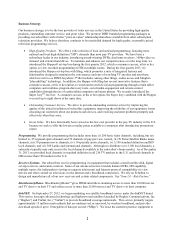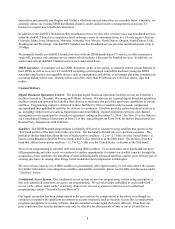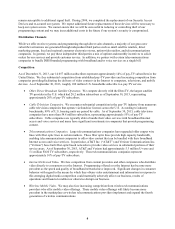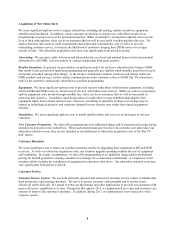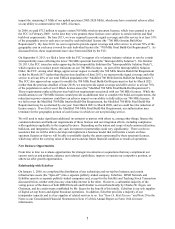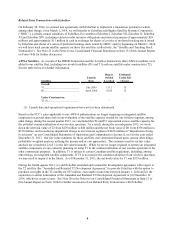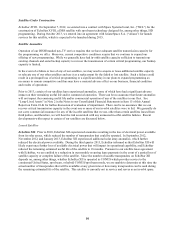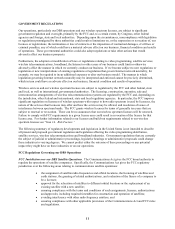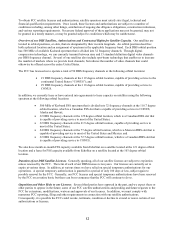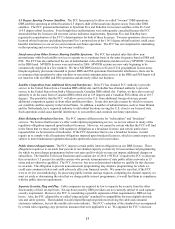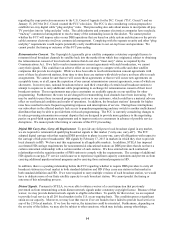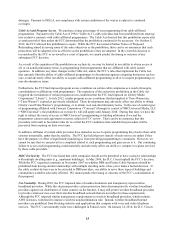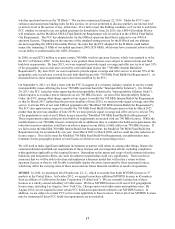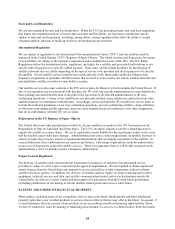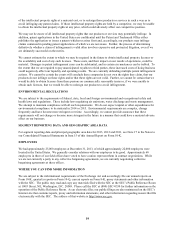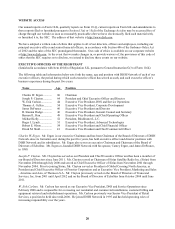Dish Network 2013 Annual Report Download - page 22
Download and view the complete annual report
Please find page 22 of the 2013 Dish Network annual report below. You can navigate through the pages in the report by either clicking on the pages listed below, or by using the keyword search tool below to find specific information within the annual report.12
12
To obtain FCC satellite licenses and authorizations, satellite operators must satisfy strict legal, technical and
financial qualification requirements. Once issued, these licenses and authorizations are subject to a number of
conditions including, among other things, satisfaction of ongoing due diligence obligations, construction milestones,
and various reporting requirements. Necessary federal approval of these applications may not be granted, may not
be granted in a timely manner, or may be granted subject to conditions which may be cumbersome.
Overview of our DBS Satellites, Authorizations and Contractual Rights for Satellite Capacity. Our satellites are
located in orbital positions, or slots, that are designated by their western longitude. An orbital position describes
both a physical location and an assignment of spectrum in the applicable frequency band. Each DBS orbital position
has 500 MHz of available Ku-band spectrum that is divided into 32 frequency channels. Through digital
compression technology, we can currently transmit between nine and 13 standard definition digital video channels
per DBS frequency channel. Several of our satellites also include spot-beam technology that enables us to increase
the number of markets where we provide local channels, but reduces the number of video channels that could
otherwise be offered across the entire United States.
The FCC has licensed us to operate a total of 50 DBS frequency channels at the following orbital locations:
x 21 DBS frequency channels at the 119 degree orbital location, capable of providing service to the
continental United States (“CONUS”); and
x 29 DBS frequency channels at the 110 degree orbital location, capable of providing service to
CONUS.
In addition, we currently lease or have entered into agreements to lease capacity on satellites using the following
spectrum at the following orbital locations:
x 500 MHz of Ku-band FSS spectrum that is divided into 32 frequency channels at the 118.7 degree
orbital location, which is a Canadian FSS slot that is capable of providing service to CONUS,
Alaska and Hawaii;
x 32 DBS frequency channels at the 129 degree orbital location, which is a Canadian DBS slot that
is capable of providing service to most of the United States;
x 32 DBS frequency channels at the 61.5 degree orbital location, capable of providing service to
most of the United States;
x 24 DBS frequency channels at the 77 degree orbital location, which is a Mexican DBS slot that is
capable of providing service to most of the United States and Mexico; and
x 32 DBS frequency channels at the 72.7 degree orbital location, which is a Canadian DBS slot that
is capable of providing service to CONUS.
We also have month-to-month FSS capacity available from EchoStar on a satellite located at the 121 degree orbital
location and a lease for FSS capacity available from EchoStar on a satellite located at the 103 degree orbital
location.
Duration of our DBS Satellite Licenses. Generally speaking, all of our satellite licenses are subject to expiration
unless renewed by the FCC. The term of each of our DBS licenses is ten years. Our licenses are currently set to
expire at various times. In addition, at various times we have relied on special temporary authorizations for our
operations. A special temporary authorization is granted for a period of only 180 days or less, subject again to
possible renewal by the FCC. Generally, our FCC licenses and special temporary authorizations have been renewed
by the FCC on a routine basis, but there can be no assurance that the FCC will continue to do so.
Opposition and Other Risks to our Licenses. Several third parties have opposed in the past, and we expect these or
other parties to oppose in the future, some of our FCC satellite authorizations and pending and future requests to the
FCC for extensions, modifications, waivers and approvals of our licenses. In addition, we must comply with
numerous FCC reporting, filing and other requirements in connection with our satellite authorizations.
Consequently, it is possible the FCC could revoke, terminate, condition or decline to extend or renew certain of our
authorizations or licenses.


